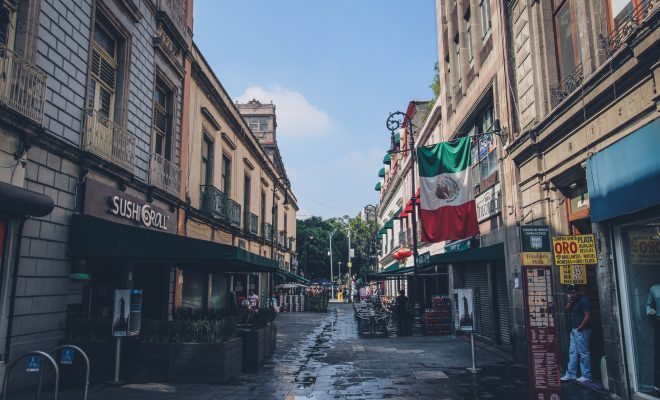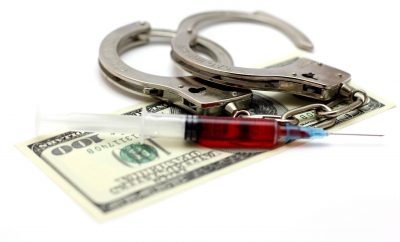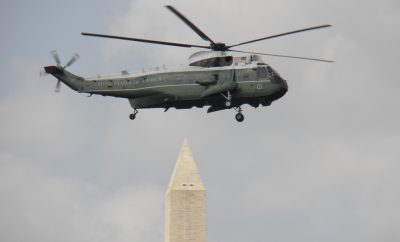 Image courtesy of [Florent Lamoureux via Flickr]
Image courtesy of [Florent Lamoureux via Flickr]
World
Finding El Chapo: What his Arrest Means for Mexico and the Drug Trade
Early in the morning on January 8, the notorious cartel leader Joaquin Guzman, also known as El Chapo, was captured, yet again, by Mexican authorities following a heated gun battle at his hideout. While Guzman’s story has a number of interesting subplots, including his multiple previous escapes and an interview with Sean Penn, it also points to something: the ongoing war on drugs taking place with its epicenter in Mexico. However, this has not always been the state of things, as South America, particularly Colombia, was once home to the heart of drug trafficking and its most infamous leader Pablo Escobar. But the recent arrest highlights how that center has moved north and, not coincidently, much closer to the U.S. border. Read on to see how the heart of the drug trade has shifted in recent years, what impact that has had in Mexico, the role of the United States, and if capturing El Chapo really makes any difference in the larger war on drugs.
It Started in South America Now it’s Here
To understand the importance of capturing someone like El Chapo, or even the Mexican drug trafficking industry in general, it is necessary to travel one step backward to Colombia. The Colombian drug trade really took off in the 1970s when marijuana traffickers began trading in cocaine because of increased American demand for the drug. Trafficking cocaine was considerably more profitable than marijuana and the growth in profits caused a dramatic increase in the scale of smuggling.
The amount of money in this industry led to the formation of two incredibly powerful competing cartels, the Medellin and the Cali Cartels. The Medellin Cartel, known for its ruthlessness and use of violence, was epitomized by its leader, the notorious Pablo Escobar. The Cali cartel, on the other hand, was much more inconspicuous, reinvesting profits in legitimate businesses and using bribery instead of violence to get its way. The competition between these two groups turned violent, eventually involving the Colombian government and even the United States.
In the 1990s, these two groups were finally undone by concerted efforts between the local Colombian government and U.S. advisors that led to their leaders being either imprisoned or killed. Since their peak, these empires have fragmented, as smaller groups took control over various parts of the cocaine-producing process. While the violence in Colombia has decreased, though not disappeared altogether, the dominant player in the drug trafficking world has shifted to Mexico.
Going North
Mexico had originally been the final corridor through which Colombian cocaine passed before entering the United States. Before Mexico, cocaine had been smuggled through the Caribbean to cities like Miami. Ultimately, though, those routes were shut down by the United States. During the peak years of operation in Colombia, Mexico was little more than a path into the United States. However, this began to change with the demise of the Cali and Medellin cartels, coupled with continued American pressure and aid packages to help the Colombian government fight the local drug trade. Due to fragmentation and weakening Colombian cartels, the center of the drug trade shifted north in Mexico. Mexico served as a natural hub due to its earlier involvement in distributing the drugs produced in Colombia.
While the Mexican cartels came to dominate the illegal drug trade, their rise preceded the actual demise of their Colombian brethren. Much of the history of modern cartels in Mexico can be traced back to one man, Miguel Angel Felix Gallardo. Gallardo was responsible for creating and maintaining the smuggling routes between Mexico and the United States. When he was arrested, his network splintered into several parts, laying the groundwork for many of the cartel divisions that exist today. The first major successor was the AFO or Tijuana/Arellano Felix organization. However, its status was usurped by the Sinaloa Cartel under El Chapo’s control.
The Sinaloa Cartel is believed to control between 40 and 60 percent of the drug trade in Mexico with that translating into annual profits of up to $3 billion, but it is only one of nine that currently dominate Mexico. The activities of these cartels have also expanded as they are now involved in other criminal activities such as kidnapping, extortion, theft, human trafficking, as well as smuggling new drugs to the United States.
The rise of the Mexican cartels can be attributed to other factors aside from the demise of the Colombian groups. One such factor was the role of the Mexican government. During the important period of their ascendancy, the cartels were largely left alone by the Mexican government, which was controlled by the Institutional Revolutionary Party (PRI) for 71 years. When the PRI’s grip on power finally loosened, the alliance with the cartels also shredded.
The growth of the Mexican cartels may also have been the result of economic problems in the United States. Stagflation in the United States led to higher interest rates on loans, which Mexico could not pay. In order to avert an economic crisis, several international institutions stepped in to bail Mexico out, which shifted the government’s focus from its economy to repaying debt. As a result of aggressive policies directed toward Mexican workers and because of the deleterious effects of the NAFTA treaty, there was a dramatic loss of jobs and a shift to a more urban population.
In this new setting, there were few opportunities available, making positions with drug cartels one of the few lucrative options along with growing the crops like poppy, which is used to create the drugs themselves. According to farmers interviewed by the Guardian, growing poppy is the only way for them to guarantee a “cash income.” An increase in the availability of firearms and other weapons smuggled south from the United States only added to the violence and chaos. The video below depicts the history of the Mexican drug trade:
Impact on Mexico
These endless wars for control between cartels in Mexico have taken a significant toll on the country. Between 2007 and 2014, for example, 164,000 people were killed in America’s southern neighbor. While not all those murders are drug-related, some estimates suggest 34 to 55 percent of homicides involve the drug war, a rate that is still incredibly high.
Aside from the number of deaths, all of the violence has influenced the Mexican people’s trust in the government as a whole. That lack of faith may be well founded as the weaknesses of the judicial and police forces are widely known. When the PRI was the single ruling party, it had effectively served as patrons to the drug cartels where an understanding was essentially worked out between the two. When the PRI lost its grip on power, this de-facto alliance between the government and the cartels also splintered. Without centralized consent, individuals at all levels of government as well as in the judiciary and police became susceptible to bribes from the various cartels. In fact, many were often presented with the choice of either going along with the cartels in exchange for money or being harmed if they resisted. The corruption and subsequent lack of trust in authorities have gotten so bad that some citizens are forming militias of their own to combat the cartels.
Role of the United States
In addition to the impact that the U.S. economy has in terms of job opportunities, particularly since the passage of NAFTA, the United States has had a major impact on the drug trade in two other ways. First are the U.S. efforts to curb the supply of drugs, which were organized as part of the overall war on drugs. While the United States has had a variety of drug laws on the books, it was not until after the 1960s that the government took direct aim at eliminating illicit substances. In 1971, President Nixon formally launched a “war on drugs,” taking an aggressive stance implementing laws like mandatory minimum sentencing and labeling marijuana as a Schedule I drug, which made it equivalent to substances like heroin in the eyes of the law.
This emphasis on drug laws only intensified under President Reagan, whose persistence in prosecuting drug crimes led to a large increase in the prison population. During Reagan’s presidency, Congress also passed the Anti-Drug Abuse Act in 1986, which forced countries receiving U.S. aid to adhere to its drug laws or lose their assistance packages. These policies more or less continued for decades, often with more and more money being set aside to increase enforcement. Only in recent years has President Barack Obama offered much of a change as he has overseen modifications in sentencing and the perception of medical marijuana laws.
This focus on supply extends beyond the U.S. border as well. First, in Colombia, the United States repeatedly put pressure on the Colombian government to fight the drug traffickers. With these efforts still ineffective and with violence mounting, the United States again poured money into the country, helping to finance needed reforms in the Colombian security forces and for other things like crop eradication. In Mexico, a similar approach followed as a series of presidents, beginning in the 1980s, took on much more combative roles against the cartels with the approval and support of the United States. The United States helped support an armed forces overhaul to combat the traffickers and root out corruption within the Mexican armed forces, which had begun to permeate as a result of low wages. In Mexico, successive governments even went so far as to send the military into cartel-dominated cities and engage in assaults. While Presidents Zedillo, Fox, and Calderon sent in troops and met with some immediate success, in the long term it led to mass army defections, greater awareness of the reach of the drug economy, and ultimately other cartels filling the void where government forces were successful.
Since the inception of the drug war, the United States has spent an estimated $1 trillion. Primarily what the United States has to show for this is a number of unintended consequences such as the highest incarceration rates in the world. Another is one of the highest rates of HIV/AIDs of any Western nation fueled, in part, by the use of dirty syringes among drug users.
The problem is that for all its efforts to eliminate supply, the United States has done much less about demand, its other contribution to the drug trade. In fact, the United States is widely regarded as the number one market in the world for illegal drugs. To address demand instead of concentrating on supply, the United States could shift more of its focus to programs that educate or offer rehabilitation to drug users, which have been shown to be effective in small scale efforts. Certain states have begun to decriminalize or legalize marijuana, a step which will certainly reduce the number of inmates and may also reduce levels of drug-related violence. Yet there is no single way to outright reduce the demand for drugs and some view decriminalization as actually fueling the problem. The following video provides an overview of the resources invested into the United Stats’ war on drugs:
The Importance of Capturing El Chapo
Considering all of the resources and efforts put in place, it is important to consider how much of an impact El Chapo’s arrest will actually have. Unfortunately, it looks like the answer is not much, if any at all. In fact, even El Chapo himself weighed in on his arrest’s effects on the drug trade, telling Sean Penn in an interview, “the day I don’t exist, it’s not going to decrease in any way at all.” El Chapo’s point is clearly illustrated through the number of drug seizures at the border. While exact amounts fluctuate, nearly 700,000 more pounds of marijuana were seized in 2011 than in 2005. The amount of heroin and amphetamines seized has also gone up as well.
The following video details El Chapo’s most recent capture:
His most recent arrest was actually his third; the first two times he escaped from maximum security prisons in stylish fashions, which is one of the reasons that U.S. authorities want Mexico to extradite him. Regardless of where he is ultimately held, since his first arrest in 1993 the drug trade has not suffered when he or any other cartel leader was captured or killed, nor has it suffered from the growth in seizures.
In fact, one of the major points of collaboration between Mexican and U.S. authorities has been on targeting, capturing, or killing of the kingpins of these cartels. While these operations have been successful in apprehending individuals, what they really result in is the further fragmentation of the drug trade. While some may argue that detaining top leaders and fragmenting the centralized drug trade is a mark of success, evidence suggests this is not so.
Conclusion
Aside from relocating the hub of the drug trade to Mexico, the war on drugs has had several other unintended consequences such as high civilian deaths, persistently high rates of HIV infection, and massive levels of incarceration to name a few. While the United States has had some success targeting suppliers and traffickers, it has been unable to reduce demand domestically.
Those involved in Mexico faced a similar conundrum. Not only do citizens in Mexico not trust their government, many of them have become dependent on the drug trade and shutting it down could actually hurt the economic prospects of many citizens.
While El Chapo’s most recent capture has the potential to provide the government with some credibility, it still may not mean much. Even if he is prevented from escaping again or running his old empire from jail, someone will likely take his place. That is because the drug trade does not rely on individuals but on demand and profits. Until these issues are addressed and Mexican citizens have legitimate alternatives to joining cartels, it does not matter how many cartel leaders are arrested, the situation will remain the same.
Resources
CNN: ‘Mission Accomplished’: Mexican President Says ‘El Chapo’ Caught
Frontline: The Colombian Cartels
Borderland Beat: The Story of Drug Trafficking in Latin America
Congressional Research Service: Mexico: Organized Crime and Drug Trafficking Organizations
Jacobin: How the Cartels Were Born
Frontline: The Staggering Death Toll of Mexico’s Drug War
Council on Foreign Relations: Mexico’s Drug War
Drug Policy Alliance: A Brief History of the Drug War
Matador Network: 10 Facts About America’s War On Drugs That Will Shock You
The Washington Post: Latin American Leaders Assail U.S. Drug ‘Market’
The Huffington Post: Why The Capture of ‘El Chapo’ Guzman Won’t Stop His Cartel
The Guardian: Mexican Farmers Turn to Opium Poppies to Meet Surge in US Heroin Demand
CIR: Drug Seizures Along the U.S.-Mexico Border








Comments